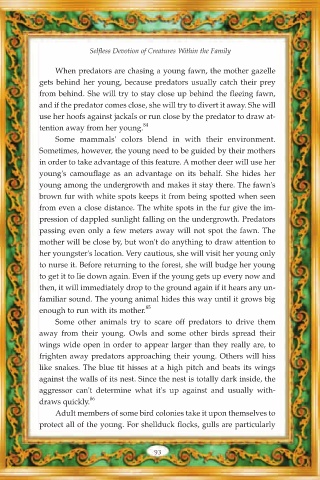Page 95 - Devotion Among Animals Revealing the Work of God
P. 95
Selfless Devotion of Creatures Within the Family
When predators are chasing a young fawn, the mother gazelle
gets behind her young, because predators usually catch their prey
from behind. She will try to stay close up behind the fleeing fawn,
and if the predator comes close, she will try to divert it away. She will
use her hoofs against jackals or run close by the predator to draw at-
84
tention away from her young.
Some mammals' colors blend in with their environment.
Sometimes, however, the young need to be guided by their mothers
in order to take advantage of this feature. A mother deer will use her
young's camouflage as an advantage on its behalf. She hides her
young among the undergrowth and makes it stay there. The fawn's
brown fur with white spots keeps it from being spotted when seen
from even a close distance. The white spots in the fur give the im-
pression of dappled sunlight falling on the undergrowth. Predators
passing even only a few meters away will not spot the fawn. The
mother will be close by, but won't do anything to draw attention to
her youngster's location. Very cautious, she will visit her young only
to nurse it. Before returning to the forest, she will budge her young
to get it to lie down again. Even if the young gets up every now and
then, it will immediately drop to the ground again if it hears any un-
familiar sound. The young animal hides this way until it grows big
enough to run with its mother. 85
Some other animals try to scare off predators to drive them
away from their young. Owls and some other birds spread their
wings wide open in order to appear larger than they really are, to
frighten away predators approaching their young. Others will hiss
like snakes. The blue tit hisses at a high pitch and beats its wings
against the walls of its nest. Since the nest is totally dark inside, the
aggressor can't determine what it's up against and usually with-
86
draws quickly.
Adult members of some bird colonies take it upon themselves to
protect all of the young. For shellduck flocks, gulls are particularly
93

